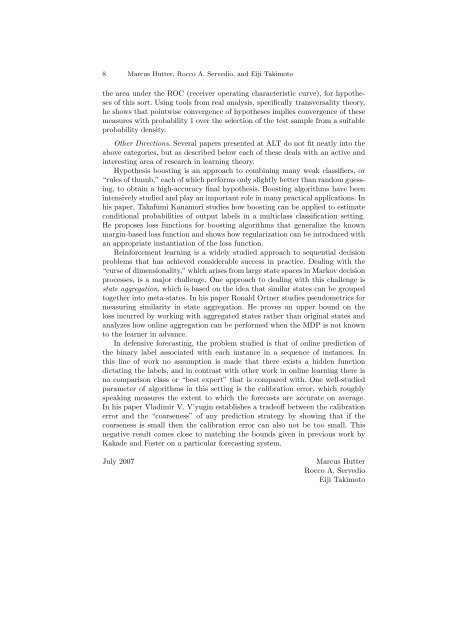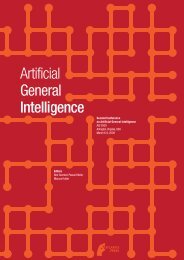Algorithmic Learning Theory - of Marcus Hutter
Algorithmic Learning Theory - of Marcus Hutter
Algorithmic Learning Theory - of Marcus Hutter
You also want an ePaper? Increase the reach of your titles
YUMPU automatically turns print PDFs into web optimized ePapers that Google loves.
8 <strong>Marcus</strong> <strong>Hutter</strong>, Rocco A. Servedio, and Eiji Takimoto<br />
the area under the ROC (receiver operating characteristic curve), for hypotheses<br />
<strong>of</strong> this sort. Using tools from real analysis, specifically transversality theory,<br />
he shows that pointwise convergence <strong>of</strong> hypotheses implies convergence <strong>of</strong> these<br />
measures with probability 1 over the selection <strong>of</strong> the test sample from a suitable<br />
probability density.<br />
Other Directions. Several papers presented at ALT do not fit neatly into the<br />
above categories, but as described below each <strong>of</strong> these deals with an active and<br />
interesting area <strong>of</strong> research in learning theory.<br />
Hypothesis boosting is an approach to combining many weak classifiers, or<br />
“rules <strong>of</strong> thumb,” each <strong>of</strong> which performs only slightly better than random guessing,<br />
to obtain a high-accuracy final hypothesis. Boosting algorithms have been<br />
intensively studied and play an important role in many practical applications. In<br />
his paper, Takafumi Kanamori studies how boosting can be applied to estimate<br />
conditional probabilities <strong>of</strong> output labels in a multiclass classification setting.<br />
He proposes loss functions for boosting algorithms that generalize the known<br />
margin-based loss function and shows how regularization can be introduced with<br />
an appropriate instantiation <strong>of</strong> the loss function.<br />
Reinforcement learning is a widely studied approach to sequential decision<br />
problems that has achieved considerable success in practice. Dealing with the<br />
“curse <strong>of</strong> dimensionality,” which arises from large state spaces in Markov decision<br />
processes, is a major challenge. One approach to dealing with this challenge is<br />
state aggregation, which is based on the idea that similar states can be grouped<br />
together into meta-states. In his paper Ronald Ortner studies pseudometrics for<br />
measuring similarity in state aggregation. He proves an upper bound on the<br />
loss incurred by working with aggregated states rather than original states and<br />
analyzes how online aggregation can be performed when the MDP is not known<br />
to the learner in advance.<br />
In defensive forecasting, the problem studied is that <strong>of</strong> online prediction <strong>of</strong><br />
the binary label associated with each instance in a sequence <strong>of</strong> instances. In<br />
this line <strong>of</strong> work no assumption is made that there exists a hidden function<br />
dictating the labels, and in contrast with other work in online learning there is<br />
no comparison class or “best expert” that is compared with. One well-studied<br />
parameter <strong>of</strong> algorithms in this setting is the calibration error, which roughly<br />
speaking measures the extent to which the forecasts are accurate on average.<br />
In his paper Vladimir V. V’yugin establishes a trade<strong>of</strong>f between the calibration<br />
error and the “coarseness” <strong>of</strong> any prediction strategy by showing that if the<br />
coarseness is small then the calibration error can also not be too small. This<br />
negative result comes close to matching the bounds given in previous work by<br />
Kakade and Foster on a particular forecasting system.<br />
July 2007<br />
<strong>Marcus</strong> <strong>Hutter</strong><br />
Rocco A. Servedio<br />
Eiji Takimoto













